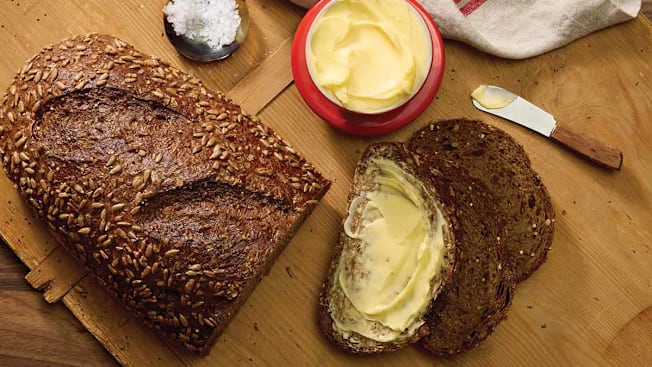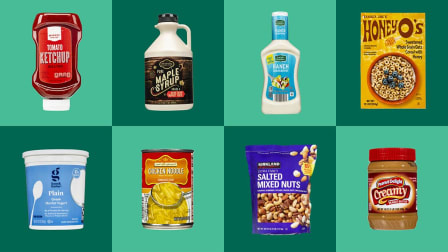8 Types of Butter and How to Use Them
It's always been rich and delicious, but now there are a lot more options in the dairy case. So which should you choose?

Butter is back. After decades as a dietary pariah, it’s a star ingredient in everything from brown butter pasta to gooey butter cake, and you may have noticed the growing variety at the supermarket. People in the U.S. eat an average of 6.5 pounds per year, up 18 percent over the past decade, according to the International Dairy Foods Association.
Why the butter renaissance? For one thing, America’s obsession with fat-free foods (many of which tended to be taste-free, too) has been eclipsed by a growing appetite for minimally processed ingredients. For another, nothing flavors food quite like butter can. When you want steak browned to perfection, you baste it in butter. For the creamiest mashed potatoes, bring on the butter. Hollandaise sauce and flaky croissants could not exist without it.
Is Butter Healthy to Eat?
Of course, butter is creamy because it’s full of fat, most of which is the saturated kind that’s been linked to a higher risk of heart disease. The Dietary Guidelines for Americans recommends getting less than 10 percent of daily calories from saturated fat (1 gram of fat has 9 calories). If you take in 1,800 calories a day, that’s 20 grams of fat. A tablespoon of butter, with 7 grams of saturated fat, has about a third of that amount.
Types of Butter
Sweet Cream Butter
This is the most common type. The term “sweet” distinguishes it from butter made from cultured cream (see below). All butter starts as cream. Producers skim it from whole milk, heat it to kill bacteria, and churn it until it separates into solid butter and buttermilk; then they often add preservatives. Butter made in the U.S. must contain at least 80 percent fat to ensure consistency among products. Sweet cream is known for its mild flavor, which makes it versatile for cooking and baking.
European-Style Butter
This style has a higher butterfat content, typically about 82 to 85 percent, which is why it tastes richer and creamier than most sweet cream varieties—and can cost almost twice as much. It’s ideal for spreading on bread. You can cook with it, but because of the richness and price, you might want to reserve it for ultra-flaky baked goods such as biscuits, piecrust, and puff pastries. Don’t be fooled by the name: Some European-style butters, such as Plugrà, are made in the U.S. Imported butters usually state the country of origin. (See the results of CR’s tests of sweet cream and European-style butters.)
Cultured Butter
Cultured means the cream has been treated with live bacteria cultures, just like yogurt, which gives a slightly tangy taste.
Clarified Butter
Made by heating butter until the water evaporates and then removing the milk solids, clarified butter is pure butterfat. It has a consistency similar to oil and a higher smoke point. That means it won’t burn easily, making it ideal for sautéing, frying eggs, and searing.
Ghee
A staple of Indian cooking, this is a type of clarified butter that’s been heated further. Its mild nutty flavor works nicely in stir-fries and aromatic dishes.
Grass-Fed
This label indicates that cows are fed mostly grass, which lends butter an herbal note.
“Light” Butter
Light butters may contain a blend of real butter and canola oil for reduced fat and calories. Whipped butter also has less fat and fewer calories because it has more air. Neither works well for baking, but they can satisfy a bread-and-butter craving.
Pasture-Raised
This is an ethical designation, meaning cows roam freely in pastures instead of being confined indoors. A diverse diet, including grass and grain, can impart a richer flavor to butter made from their milk.
What About Butter Substitutes?
If you’d like to cut back on butter or you prefer plant-based foods, there are alternatives. But they’re not necessarily better for you than regular butter and usually can’t match its flavor or effect when cooking or baking.
Margarine is typically made from a blend of vegetable oils like soybean or sunflower. Avoid any that contain palm oil, which is high in saturated fat, says Ethan Balk, PhD, RDN, a dietitian and clinical associate professor of clinical nutrition at New York University. Margarine isn’t always good for baking; cookies may not crisp up, for example.
Plant-based spreads are dairy-free and made from a combination of oils such as olive or avocado. Just be sure to check the list of ingredients for unhealthy oils like coconut and palm.
Buttery sprays are low in calories and fat. They give grilled food, vegetables, and popcorn a quick flavor and can be used to grease pans. But these spritzes tend to contain high amounts of artificial ingredients.
Salted or Unsalted?
The amount of salt in butter varies by brand, from ⅓ to ¾ teaspoon per stick. So it’s usually better to choose unsalted butter for cooking and baking—and add the salt separately—to give you more control over flavor.
Getting the Most From Butter
There are simple ways to get all the creamy deliciousness you love with less fat—and some smart swaps to try.
Maximize the flavor. Use butter as a finishing touch. Do this instead of using it as a cooking fat, says James Briscione, a chef and culinary adviser at Samford University in Birmingham, Ala. If you sauté vegetables in olive oil and then toss them with a pat of butter, you’ll still get a satisfying result.
Try a taste tweak. Heat sweet cream or European butter over a low flame for 5 to 10 minutes to make nutty brown butter; a little goes a long way. Or experiment with cutting half the butter in a fish or pasta dish and instilling umami flavor with miso, low-sodium soy sauce, or nutritional yeast.
Spice it up. A bit of compound butter can season food well. To make it, Briscione recommends softening a stick of butter, then mixing in ½ tablespoon each of parsley, chives, and tarragon, and the zest of half a lemon.
Use oil for some baking. When recipes for muffins, brownies, or quick breads call for melted butter, you can swap in oil, says Austin Scoles, an instructor in the College of Food Innovation & Technology at Johnson & Wales University in Provincetown, R.I. Go with ¾ cup of oil per cup of butter. But don’t reduce the amount of butter in a recipe if it’s being creamed with sugar. That process creates air pockets and the light texture you want in baked goods like cakes and cookies.
Serving Ideas
Hard, cold butter can be tough to spread and doesn’t taste as good, either. Before you serve butter, try these tips.
Choose a softie. European-style and grass-fed butters tend to be creamier, thanks to their unique fat composition, says Gina Mode, a coordinator at the University of Wisconsin Center for Dairy Research in Madison.
Zap it. If you forgot to take butter out of the fridge at least an hour before serving it, place the stick in the microwave in a microwave-safe bowl, then heat at 10-second intervals until it’s soft.
Make the cut. Slice butter into pats and arrange them on a plate; they’ll soften faster than a stick does.
Shred it. Grate cold butter over pancakes or veggies before serving; it will melt evenly.
Keeping Butter Fresh
Butter easily absorbs odors from other foods, and exposure to air can oxidize it and make it turn rancid faster. Here’s how to help it taste fresh for longer.
In the fridge: Put butter in an airtight glass or porcelain container, leaving it in its wrapper until you need it. The butter will last one to three months.
In the freezer: Individual sticks stored in their original packaging and wrapped with foil (to avoid freezer burn) can last up to a year.
On the counter: A butter crock is a two-piece container. You pack softened butter into the lid, then invert it into a base filled with a little water. The water creates a seal that keeps the butter from spoiling for several weeks while maintaining softness and spreadability. Check out the best butter crocks from CR’s tests.
Editor’s Note: This article also appeared in the November/December 2025 issue of Consumer Reports magazine.




















